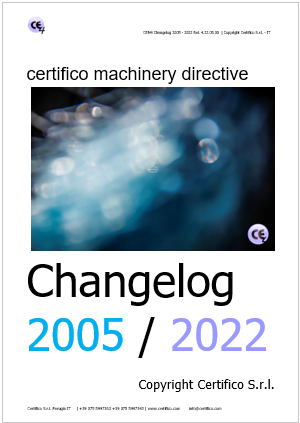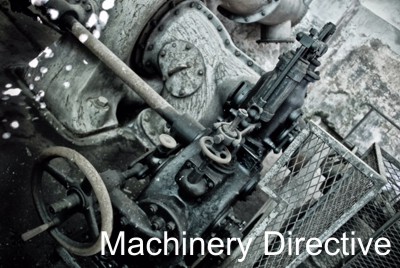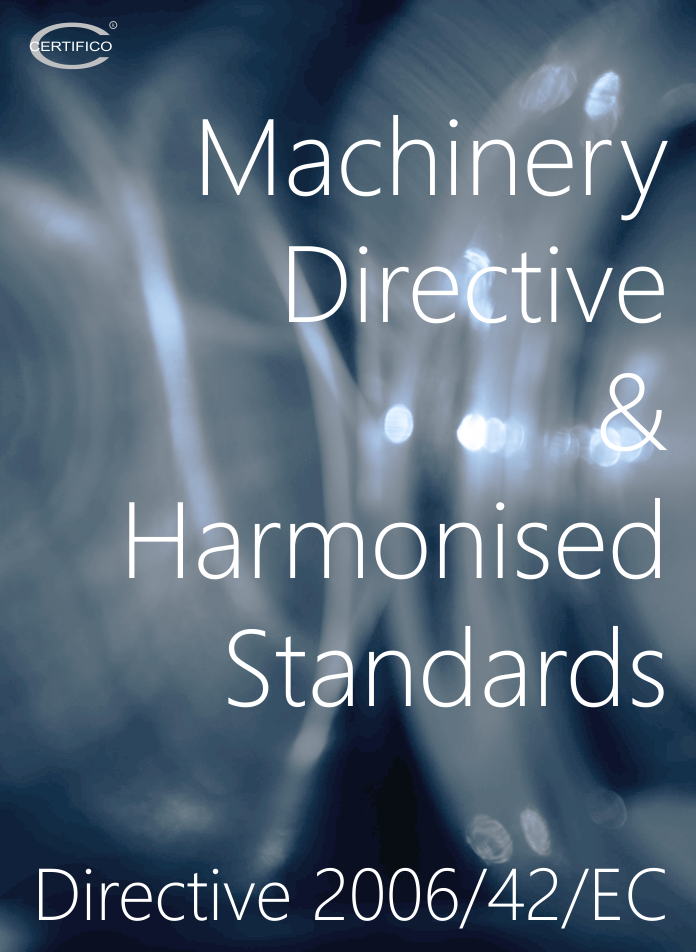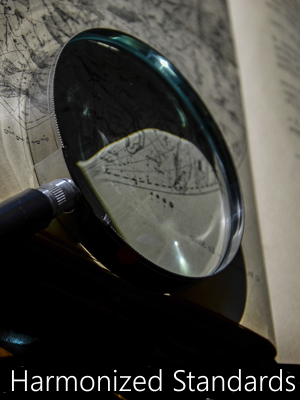Posted in News
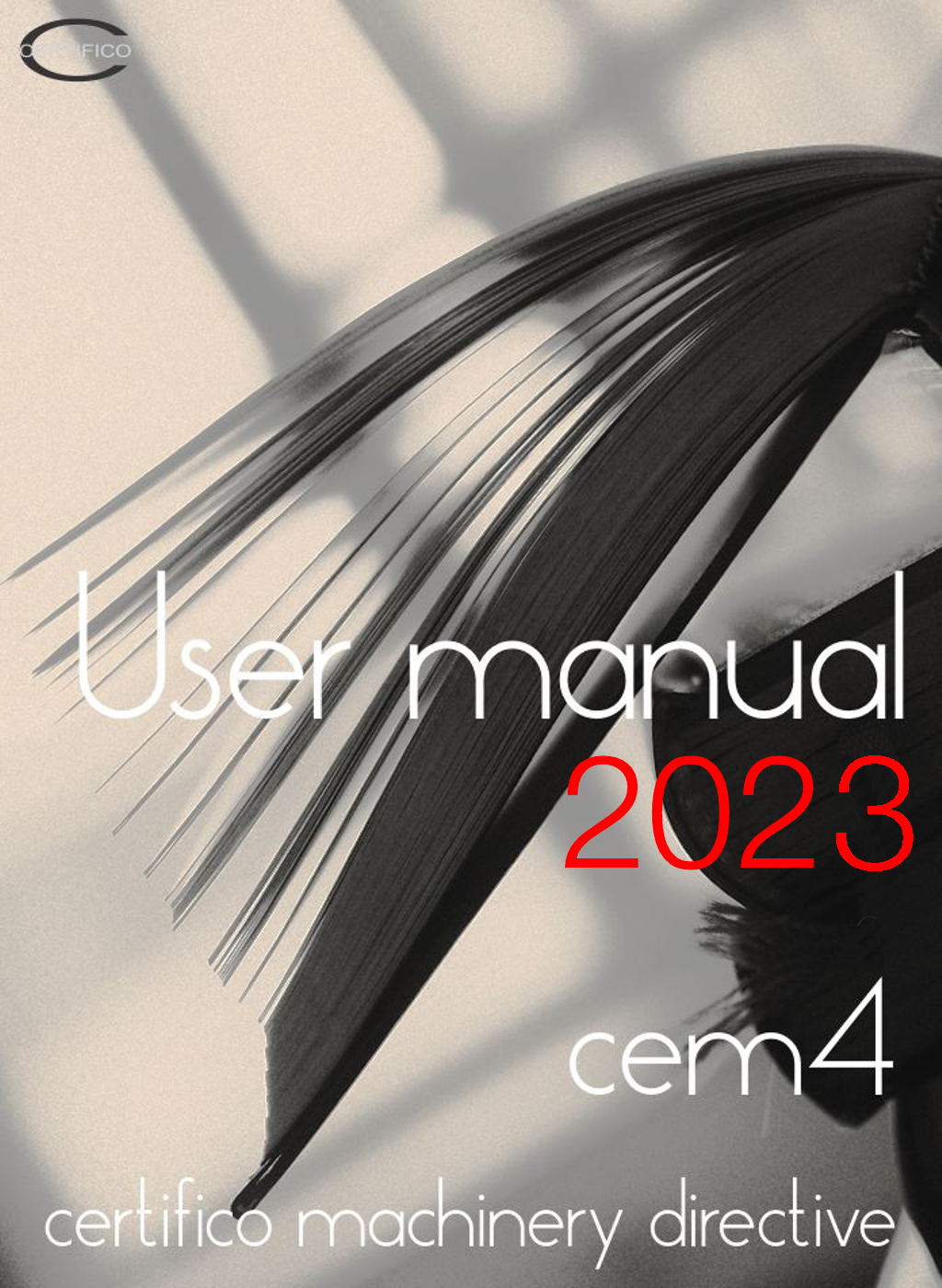
CEM4 Manuale d'Uso ebook / 2023
Ed. 2023
Il presente ebook è il manuale d'uso ufficiale di Certifico Macchine 4 (CEM4): il software per il nuovo Regolamento macchine (UE) 2023/1230 e la Direttiva Macchine 2006/42/CE.
- Published: 21 July 2023
- Hits: 10696
Posted in News
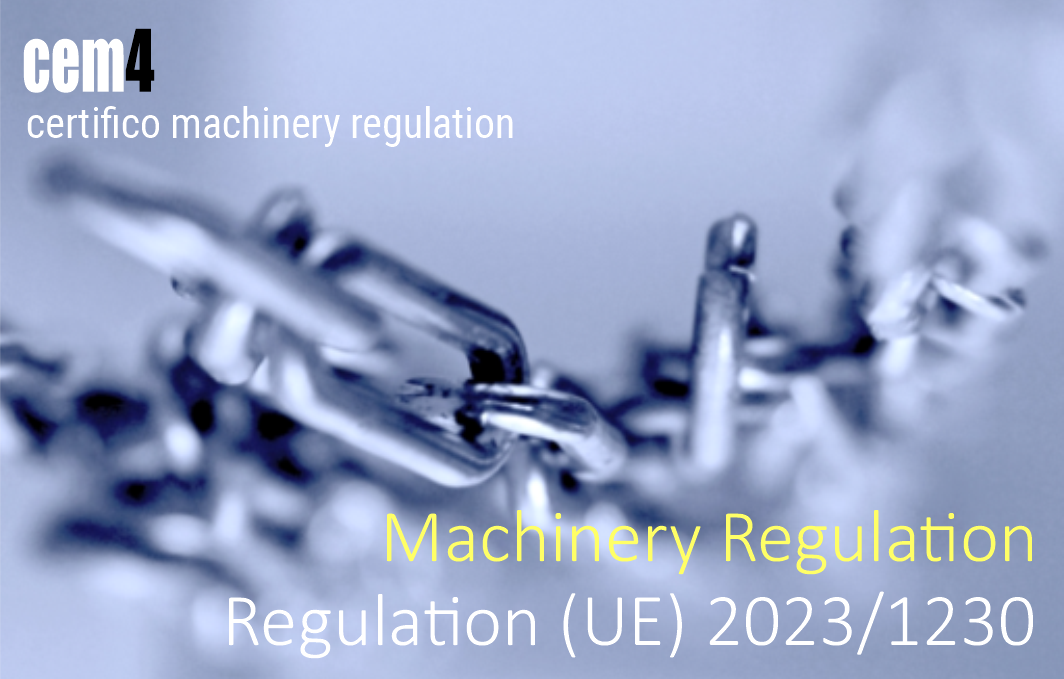
CEM4 July 2023 Update 4 (Regulation (EU) 2023/1230 "Machinery")
19 July 2023
CEM4 has been update to the Machinery Regulation 2023 (Regulation (EU) 2023/1230 (IT) (EN)
- Published: 07 July 2023
- Hits: 8502
Posted in News
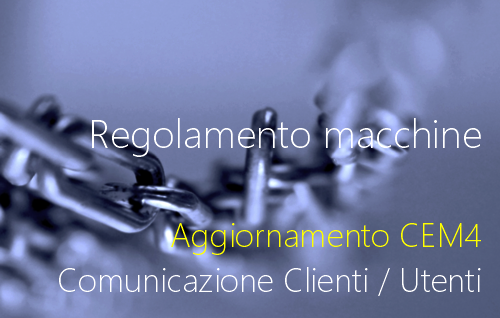
Regolamento macchine: aggiornamento di CEM4 - Comunicazione Clienti / Utenti
Com. 29.06.2023
Gentile Cliente / Utente,
segnaliamo che nei prossimi giorni sarà rilasciato l’aggiornamento di CEM4 al nuovo Regolamento macchine (UE) 2023/1230 versione IT e versione EN, possibile rilascio di quest’ultima in successivo aggiornamento.
1. Per i Clienti in possesso di Licenza in regola con gli aggiornamenti
1a) Modalità
Installazione pacchetto in autoupdate proposto dal software.
Dopo l’istallazione sarà possibile effettuare switch tra la Direttiva 2006/42/CE ed il Regolamento (UE) 2023/1230 e viceversa in modo semplice ed in qualsiasi momento, è garantita la compatibilità completa con quanto già realizzato con CEM4.
Non sono presenti modifiche alle funzionalità, salvo la modifiche di sviluppo per l’adeguamento normativo di finestre e documenti report quali DC, DI, VR RESS e altro previsti per il rispetto degli obblighi che introduce/modifica il Regolamento.
1b) Costi
Nessun costo aggiuntivo per l’aggiornamento.
2. Nuovi Clienti
2a) Modalità
Setup completo / aggiornamento al Regolamento, se non rilasciato, del pacchetto in autoupadate proposto dal software (vedi anche 1a)
2b) Costi
Fino al 31 Luglio prezzo attuale Store, dal 1° Agosto 2023 aumento listino del 20% ca.
Per i costi attuali e quelli previsti dal 1° Agosto 2023, vedasi: Licenze CEM4.
E’ possibile sempre utilizzare i Codici Promo del Livello Fidelity Cliente previsto.
Grazie e Cordiali Saluti,
Ing. Marco Maccarelli
AU Certifico Srl
www.certifico.com / www.cem4.eu
- Published: 29 June 2023
- Hits: 7235
Posted in News
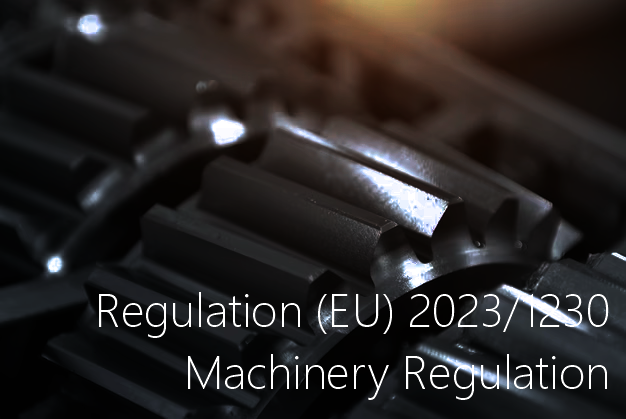
Regulation (EU) 2023/1230 / Machinery Regulation
Download Text Machinery Regulation EN
Regulation (EU) 2023/1230 of the European parliament and of the Council of 14 June 2023 on machinery and repealing Directive 2006/42/EC of the European Parliament and of the Council and Council Directive 73/361/EEC.
(OJ n. 165/1 del 29.06.2023)
Enter into force: 19.07.2023
_______
Article 51 Repeals
1. Directive 73/361/EEC is repealed.
References to the repealed Directive 73/361/EEC shall be construed as references to this Regulation.
2. Directive 2006/42/EC is repealed with effect from 14 January 2027.
References to the repealed Directive 2006/42/EC shall be construed as references to this Regulation and shall be read in accordance with the correlation table in Annex XII.
Article 52 Transitional provisions
1. Member States shall not impede the making available on the market of products which were placed on the market in conformity with Directive 2006/42/EC before 14 January 2027. However, Chapter VI of this Regulation shall apply, from 13 July 2023, mutatis mutandis to such products instead of Article 11 of that Directive, including products for which a procedure has already been initiated under Article 11 of Directive 2006/42/EC.
2. EC type-examination certificates and approval decisions issued in accordance with Article 12 of Directive 2006/42/EC shall remain valid until they expire.
Article 54 Entry into force and application
This Regulation shall enter into force on the twentieth day following that of its publication in the Official Journal of the European Union.
It shall apply from 14 January 2027.
However, the following Articles shall apply from the following dates:
(a) Articles 26 to 42 from 14 January 2024;
(b) Article 50(1) from 14 October 2023;
(c) Article 6(7) and Articles 48 and 52 from 13 July 2023;
(d) Article 6(2) to (6), (8) and (11) and Articles 47 and 53(3) from 14 July 2024.
[...]
segue in allegato
- Published: 29 June 2023
- Hits: 10346
Posted in News
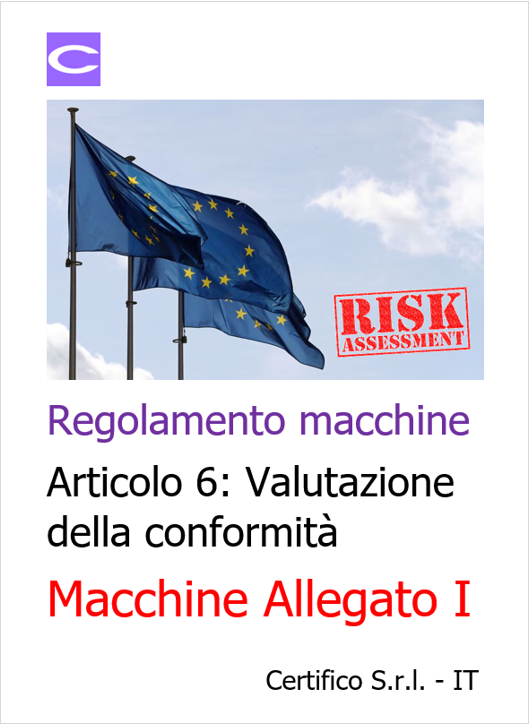
Regolamento macchine Articolo 6: Valutazione della conformità macchine Allegato I / EN ISO 12100 - ISO/TR 14121-2
Documento di approfondimento sull’introduzione, mediante l’articolo 6 del nuovo Regolamento Macchine di prossima pubblicazione, del criterio di valutazione del rischio che la Commissione Europea deve applicare in caso di aggiunta/eliminazione macchine dall’Allegato I. Il presente documento vuole mettere in evidenza le similitudini tra il criterio riportato (rif. Art. 6, c. 4) e le norme tecniche EN ISO 12100:2010 “Sicurezza del macchinario - Principi generali di progettazione - Valutazione del rischio e riduzione del rischio “ ed ISO/TR 14121-2:2012 “Sicurezza del macchinario - Valutazione del rischio - Parte 2: Guida pratica ed esempi di metodi”.
L’allegato I definisce un elenco di macchine e prodotti correlati che presentano fattori di rischio elevati e che, pertanto, sono soggetti a specifiche procedure di valutazione della conformità.
Bozza Regolamento Macchine adottato dal Consiglio in data 22 maggio 2023
Capo IV
Valutazione della conformità
Articolo 25
Procedure di valutazione della conformità per le macchine e i prodotti correlati
1. Il fabbricante o la persona fisica o giuridica di cui all'articolo 18 applica una delle procedure per la valutazione della conformità di cui ai paragrafi 2, 3 e 4. 2. Se la categoria di macchine o prodotti correlati è elencata nell'allegato I, parte A, il fabbricante o la persona fisica o giuridica di cui all'articolo 18 applica una delle procedure seguenti:
a) l’esame UE del tipo (modulo B) di cui all'allegato VII, seguito dalla conformità al tipo basata sul controllo interno della produzione (modulo C) di cui all'allegato VIII;
b) la conformità basata sulla garanzia qualità totale (modulo H) di cui all'allegato IX;
c) la conformità basata sulla verifica di un unico prodotto (modulo G) di cui all'allegato X.
3. Se la categoria di macchine o prodotti correlati è elencata nell'allegato I, parte B, il fabbricante o la persona fisica o giuridica di cui all'articolo 18 applica una delle procedure seguenti:
a) il controllo interno della produzione (modulo A) di cui all'allegato VI;
b) l'esame UE del tipo (modulo B) di cui all'allegato VII, seguito dalla conformità al tipo basata sul controllo interno della produzione (modulo C) di cui all'allegato VIII;
c) la conformità basata sulla garanzia qualità totale (modulo H) di cui all'allegato IX;
d) la conformità basata sulla verifica di un unico prodotto (modulo G) di cui all'allegato X.
Se applica la procedura di controllo interno della produzione di cui alla lettera a), il fabbricante progetta e costruisce la macchina o il prodotto correlato conformemente alle norme armonizzate o alle specifiche comuni proprie a tale categoria di macchine o prodotti correlati riguardanti tutti i pertinenti requisiti essenziali di sicurezza e di tutela della salute.
Se la categoria di macchine o prodotti correlati è elencata nell'allegato I, parte B, e la macchina o il prodotto correlato non sono stati fabbricati conformemente alle norme armonizzate o alle specifiche comuni riguardanti tutti i pertinenti requisiti essenziali di sicurezza di tutela della salute per tale categoria di macchine o prodotti correlati, il fabbricante, compresa una persona fisica o giuridica di cui all’articolo 18, applica una delle procedure di cui alle lettere b), c) o d) del presente paragrafo.
4. Se la categoria di macchine o prodotti correlati non è elencata nell'allegato I, il fabbricante, compresa la persona fisica o giuridica di cui all'articolo 18 applica la procedura di controllo interno della produzione (modulo A) di cui all'allegato VI.
5. Gli organismi notificati tengono conto degli interessi e delle esigenze specifici delle piccole e medie imprese quando definiscono tariffe per la valutazione della conformità.
L'elenco di prodotti di cui all'allegato IV della Direttiva 2006/42/CE si è fondato sinora sul rischio derivante dall'uso previsto o da qualsiasi uso scorretto ragionevolmente prevedibile di tali prodotti o dalla loro funzione protettiva essenziale. Ciò nonostante il settore delle macchine accoglie modi nuovi di progettare e costruire macchine o prodotti correlati che potrebbero presentare fattori di rischio più elevati, indipendentemente da tale uso previsto o da qualsiasi uso scorretto ragionevolmente prevedibile. Ad esempio, i sistemi con comportamento evolutivo che garantiscono funzioni di sicurezza dovrebbero essere inclusi nell'allegato I a causa delle loro caratteristiche quali la dipendenza dai dati, l'opacità, l'autonomia e la connettività, che potrebbero aumentare considerevolmente la probabilità e la gravità del danno e compromettere gravemente la sicurezza della macchina o del prodotto correlato. Pertanto, la valutazione della conformità di un componente di sicurezza o di un sistema con comportamento evolutivo che garantisce funzioni di sicurezza dovrebbe essere effettuata da terzi, indipendentemente dal fatto che il componente di sicurezza sia stato immesso sul mercato in modo indipendente o sia parte di un sistema incorporato in una macchina immessa sul mercato. Tuttavia, se una macchina incorpora un sistema il cui componente di sicurezza è già stato sottoposto a una valutazione della conformità da parte di terzi al momento della sua immissione sul mercato in modo indipendente, tale macchina non dovrebbe essere nuovamente certificata da terzi unicamente sulla base dell'incorporazione di tale sistema.
Al fine di garantire condizioni uniformi di esecuzione del regolamento, è opportuno attribuire alla Commissione competenze di esecuzione per la definizione di un modello uniforme per la raccolta di dati e di informazioni ai fini dell'aggiunta di una categoria di macchine o di prodotti correlati all'allegato I o dell’eliminazione di una categoria di macchine o di prodotti correlati dall'allegato I, per la definizione di specifiche comuni per i requisiti essenziali di sicurezza e di tutela della salute di cui all’allegato III, per richiedere allo Stato membro notificante di adottare le misure correttive necessarie in relazione a un organismo notificato che non soddisfa i requisiti per la sua notifica, e per stabilire se una misura nazionale concernente prodotti rientranti nell’ambito di applicazione del presente regolamento conformi che uno Stato membro ritiene presentino un rischio per la salute e la sicurezza delle persone, in particolare dei consumatori e degli utilizzatori professionali o, all’occorrenza degli animali domestici nonché per la tutela dei beni o, se del caso, dell’ambiente, sia giustificata. È altresì opportuno che tali competenze siano esercitate conformemente al Regolamento (UE) n. 182/2011 del Parlamento europeo e del Consiglio.
L’articolo 6 del nuovo Regolamento Macchine definisce le categorie di macchine e prodotti correlati elencati nell'allegato I soggetti a procedure specifiche di valutazione della conformità.
Bozza Regolamento Macchine adottato dal Consiglio in data 22 maggio 2023
Articolo 6
Categorie di macchine e prodotti correlati elencati nell'allegato I soggetti a procedure specifiche di valutazione della conformità
1. Le macchine e i prodotti correlati che rientrano nelle categorie elencate nell'allegato I, parte A, sono soggetti alle procedure specifiche di valutazione della conformità di cui all'articolo 25, paragrafo 2, e le macchine e i prodotti correlati che rientrano nelle categorie elencate nell'allegato I, parte B, sono soggetti alle procedure specifiche di valutazione della conformità di cui all'articolo 25, paragrafo 3. 2. Alla Commissione è conferito il potere di adottare atti delegati conformemente all'articolo 47 al fine di modificare l'allegato I, previa consultazione delle pertinenti parti interessate, in considerazione dei progressi e dell'evoluzione delle conoscenze in ambito tecnico o di nuovi dati scientifici, aggiungendo all'elenco delle categorie di macchine o prodotti correlati di cui all'allegato I una nuova categoria di macchine o prodotti correlati o eliminando una categoria esistente di macchine o prodotti correlati da tale elenco o spostando una categoria di macchine o prodotti correlati da una parte ad un’altra di tale allegato, conformemente ai criteri di cui ai paragrafi 4, 5 e 7 del presente articolo.
3. Prima dell'adozione dell'atto delegato la Commissione chiede il parere degli esperti del pertinente gruppo di esperti in conformità dell'articolo 47, paragrafo 4.
4. La Commissione valuta la gravità del potenziale rischio intrinseco che presenta una categoria di macchine o prodotti correlati al fine di stabilire se aggiungere tale categoria di macchine o prodotti correlati all'allegato I o se eliminarla da tale allegato. Tale valutazione è stabilita sulla base della combinazione della probabilità del verificarsi del danno e della gravità di quest'ultimo.
Nel determinare la probabilità e la gravità del danno, sono presi in considerazione, se del caso, i criteri seguenti:
a) la natura del pericolo intrinseco alla funzione della categoria di macchine o prodotti correlati, tenendo conto dell'uso previsto e di qualsiasi uso scorretto ragionevolmente prevedibile;
b) la gravità del danno che una persona subirebbe, incluso il grado di reversibilità del danno;
c) il numero di persone potenzialmente interessate dal danno;
d) la frequenza e la durata dell'esposizione al pericolo al quale una persona sarebbe esposta nel corso dell'uso previsto o di qualsiasi uso scorretto ragionevolmente prevedibile della categoria di macchine o prodotti correlati;
e) le possibilità di evitare o di limitare il danno;
f) per quanto riguarda i componenti di sicurezza, la probabilità di conseguenze gravi per la sicurezza delle persone esposte al danno in caso di guasto di tali componenti.
[...]
ALLEGATO I
Categorie di macchine o prodotti correlati per le quali va applicata una delle procedure di cui all'articolo 25, paragrafi 2 e 3
Parte A Categorie di macchine o prodotti correlati per le quali va applicata una delle procedure di cui all'articolo 25, paragrafo 2:
1. Dispositivi amovibili di trasmissione meccanica, compresi i loro ripari.
2. Ripari dei dispositivi amovibili di trasmissione meccanica.
3. Ponti elevatori per veicoli.
4. Apparecchi portatili a carica esplosiva per il fissaggio o altre macchine ad impatto.
5. Componenti di sicurezza dotati di un comportamento integralmente o parzialmente autoevolutivo che utilizzano approcci di apprendimento automatico che garantiscono funzioni di sicurezza.
6. Macchine che integrano sistemi con un comportamento integralmente o parzialmente autoevolutivo che utilizzano approcci di apprendimento automatico che garantiscono funzioni di sicurezza che non sono state immesse in modo indipendente sul mercato, solo per quanto riguarda tali sistemi.
Parte B Categorie di macchine o prodotti correlati per le quali va applicata una delle procedure di cui all'articolo 25, paragrafo 3:
1. Seghe circolari (monolama e multilame) per la lavorazione del legno e di materie con caratteristiche fisiche simili o per la lavorazione della carne e di materie con caratteristiche fisiche simili, dei tipi seguenti: 1.1. seghe a lama/e in posizione fissa nel corso del taglio, con tavola o supporto del pezzo fissi, con avanzamento manuale del pezzo o con dispositivo di trascinamento amovibile;
1.2. seghe a lama/e in posizione fissa nel corso del taglio, a tavola cavalletto o carrello a movimento alternato, a spostamento manuale;
1.3. seghe a lama/e in posizione fissa nel corso del taglio, dotate di un dispositivo di avanzamento integrato dei pezzi da segare a carico e/o scarico manuale;
1.4. seghe a lama/e mobile/i durante il taglio, a dispositivo di avanzamento integrato, a carico e/o scarico manuale.
2. Spianatrici ad avanzamento manuale per la lavorazione del legno.
3. Piallatrici su una faccia, ad avanzamento integrato, a carico e/o scarico manuale per la lavorazione del legno.
4. Seghe a nastro a carico e/o scarico manuale per la lavorazione del legno e di materie con caratteristiche fisiche simili o per la lavorazione della carne e di materie con caratteristiche fisiche simili, dei tipi seguenti: 4.1. seghe a lama/e in posizione fissa durante il taglio, con tavola o supporto del pezzo fissi o a movimento alternato;
4.2. seghe a lama/e montata/e su un carrello a movimento alternato.
5. Macchine combinate dei tipi di cui ai punti da 1 a 4 e al punto 7 per la lavorazione del legno e di materie con caratteristiche fisiche simili.
6. Tenonatrici a mandrini multipli ad avanzamento manuale per la lavorazione del legno.
7. Fresatrici ad asse verticale, "toupies" ad avanzamento manuale per la lavorazione del legno e di materie con caratteristiche fisiche simili
8. Seghe a catena portatili da legno.
9. Presse, comprese le piegatrici, per la lavorazione a freddo dei metalli, a carico e/o scarico manuale, i cui elementi mobili di lavoro possono avere una corsa superiore a 6 mm e una velocità superiore a 30 mm/s.
10. Formatrici delle materie plastiche per iniezione o compressione a carico o scarico manuale.
11. Formatrici della gomma a iniezione o compressione, a carico o scarico manuale.
12. Macchine per lavori sotterranei dei tipi seguenti:
12.1. locomotive e benne di frenatura;
12.2. armatura semovente idraulica.
13. Veicoli per la raccolta di rifiuti domestici a carico manuale dotate di un meccanismo di compressione.
14. Apparecchi per il sollevamento di persone o di persone e cose, con pericolo di caduta verticale superiore a 3 metri.
15. Dispositivi di protezione per rilevare la presenza di persone.
16. Ripari mobili automatici interbloccati progettati per essere utilizzati come mezzi di protezione nelle macchine di cui ai punti 9, 10 e 11 della presente parte.
17. Blocchi logici per assicurare funzioni di sicurezza.
18. Strutture di protezione in caso di ribaltamento (ROPS). 19. Strutture di protezione contro la caduta di oggetti (FOPS)
Tabella raffronto criterio di valutazione del rischio Articolo 6 Regolamento Macchine / Norme Tecniche EN ISO 12100 e ISO/TR 14121-2
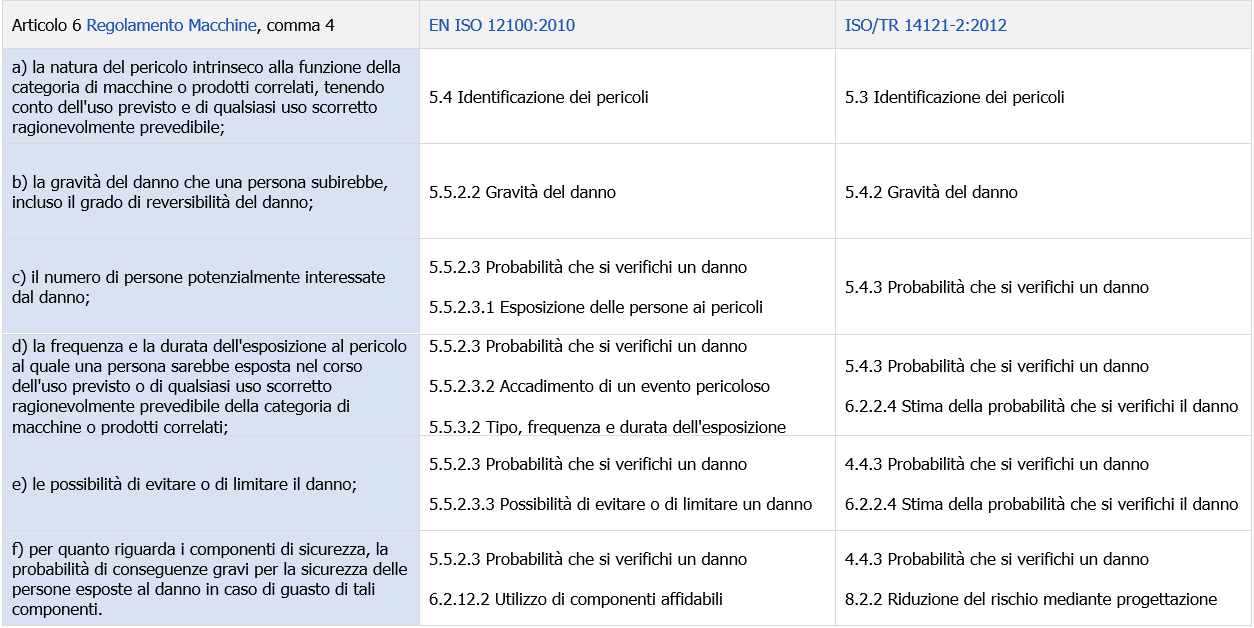

[...]
Da ISO/TR 14121-2 (Elaborato CEM4) Stima del rischio es:

[...] segue in allegato
- Published: 20 June 2023
- Hits: 5069
Posted in News
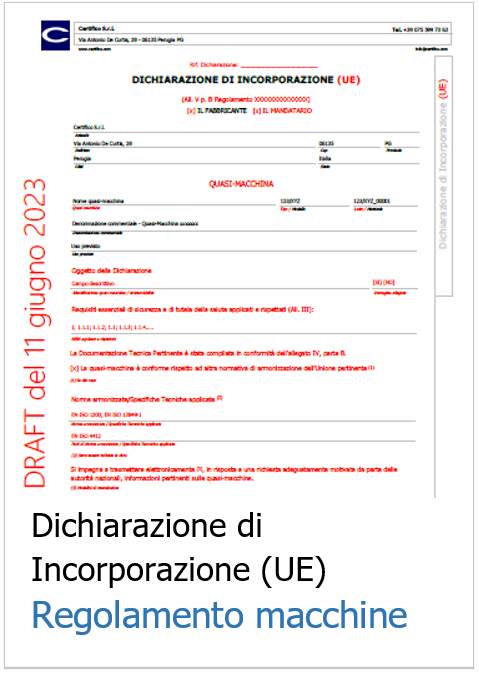
Modello di Dichiarazione di Incorporazione (UE) Regolamento macchine / Template CEM4 - Draft 11 giugno 2023
Proponiamo Draft 11.06.2023 di Modello di Dichiarazione di Incorporazione (UE) di Quasi-macchine di cui al Regolamento macchine 2023 elaborato template CEM4, su testo Regolamento macchine approvato definitivamente dal Consiglio PE-CONS 6-23 in data 23.05.2023 - non in GU.
Attenzione:
DRAFT 11.06.2023 / non definitivo, si attende pubblicazione Regolamento in GU - Template Certifico / CEM4 - in rosso le novità.
Presenti altri campi non previsti dal regolamento, quali "Uso previsto" e "Denominazione commerciale" utili sia ad aspetti tecnici che di rintracciabilità.
ALLEGATO V DICHIARAZIONE DI CONFORMITÀ UE E DICHIARAZIONE DI INCORPORAZIONE UE
Parte B DICHIARAZIONE DI INCORPORAZIONE UE DI QUASI-MACCHINE n. …(1)
La dichiarazione di incorporazione deve contenere gli elementi seguenti:
1. Quasi-macchina (numero di prodotto, di tipo, di modello, di lotto o di serie).
2. Nome e indirizzo del fabbricante e, se del caso, del suo mandatario.
3. La presente dichiarazione di incorporazione è rilasciata sotto l'esclusiva responsabilità del fabbricante.
4. Oggetto della dichiarazione (identificazione della quasi-macchina che ne consenta la rintracciabilità; se necessario per l'identificazione della quasi-macchina, si può includere un'immagine a colori sufficientemente chiara).
5. Un'indicazione con la quale si dichiara esplicitamente quali requisiti essenziali di sicurezza e di tutela della salute di cui all’allegato III del regolamento (UE) …/… del Parlamento europeo e del Consiglio sono applicati e rispettati e che la documentazione tecnica pertinente è stata compilata in conformità dell'allegato IV, parte B e, se del caso, un'indicazione con la quale si dichiara che la quasi-macchina è conforme rispetto ad altra normativa di armonizzazione dell'Unione pertinente.
6. Riferimenti alle norme armonizzate di cui all'articolo 20, paragrafo 1, o alle specifiche comuni adottate dalla Commissione conformemente all'articolo 20, paragrafo 3, che sono state applicate, compresa la data della norma o della specifica comune, oppure riferimenti ad altre specifiche tecniche, compresa la data, in relazione alla quale si dichiara la conformità. In caso di applicazione parziale delle norme armonizzate o delle specifiche comuni la dichiarazione UE di incorporazione deve specificare le parti che sono state applicate.
7. Un impegno a trasmettere, in risposta a una richiesta adeguatamente motivata da parte delle autorità nazionali, informazioni pertinenti sulle quasi-macchine. L'impegno deve comprendere le modalità di trasmissione e lasciare impregiudicati i diritti di proprietà intellettuale del fabbricante della quasi-macchina.
8. Una dichiarazione secondo cui la quasi-macchina non deve essere messa in servizio finché la macchina finale in cui deve essere incorporata non è stata dichiarata conforme al presente regolamento.
9. Informazioni supplementari:
Firmato a nome e per conto di: …
(luogo e data del rilascio):
(nome e cognome, funzione) (firma):
(1) L'assegnazione di un numero alla dichiarazione di conformità è opzionale.
Quasi-macchine / Nota
Articolo 3 Definizioni
10) "quasi-macchine": un insieme che non costituisce ancora una macchina in quanto, da solo, non è in grado di eseguire un'applicazione specifica e che è soltanto destinato a essere incorporato o assemblato ad altre macchine o ad altre quasi-macchine o apparecchi per costituire una macchina;...
- Published: 11 June 2023
- Hits: 6523
Posted in News
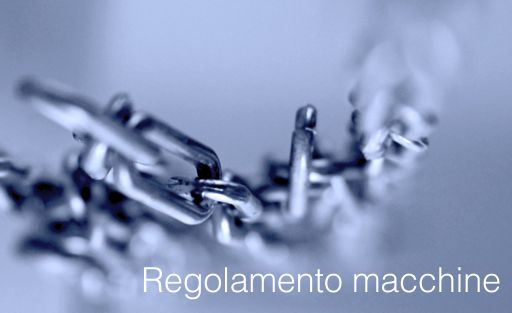
La nuova sezione dedicata al Regolamento macchine 2023
La nuova Sezione del sito certifico.com dedicata al Regolamento macchine 2023, in pubblicazione, riporterà documenti, norme, circolari, altro, che saranno elaborati/emanati in merito al Regolamento macchine 2023.
Vedi:
www.certifico.com/regolamento-macchine
- Published: 08 June 2023
- Hits: 5150
Posted in News
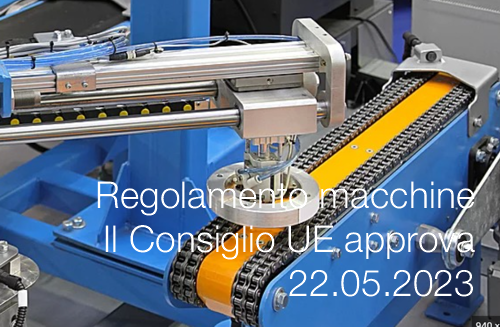
Nuovo Regolamento macchine: il Consiglio approva definitivamente / 22.05.2023
Comunicato Stampa Consiglio dell'UE del 22.05.2023
Il Consiglio ha adottato il 25 maggio 2023 il nuovo regolamento macchine. La normativa proposta aggiorna la direttiva "macchine" del 2006 e la trasforma in un regolamento. Il nuovo testo armonizza i requisiti essenziali in termini di sicurezza e di tutela della salute applicabili alle macchine nell'UE, promuove la libera circolazione delle macchine e assicura un livello elevato di sicurezza per lavoratori e cittadini.
Le norme aggiornate consentiranno all'industria europea di operare nell'ambito di un quadro giuridico nuovo e migliorato. Garantiranno un elevato livello di protezione ai nostri lavoratori e ai nostri cittadini, migliorando nel contempo la competitività e la reputazione delle macchine nell'UE.
Il regolamento adottato il 22 maggio 2023 rende obbligatoria una valutazione della conformità da parte di terzi per sei categorie di macchine che presentano rischi elevati.
Le informazioni sulla sicurezza dovranno essere fornite per tutti i prodotti ma, in linea con la transizione digitale, il regolamento stabilisce che le istruzioni digitali saranno l'opzione predefinita. Le istruzioni cartacee rimarranno un'opzione per i clienti che ne faranno richiesta.
La direttiva "macchine" del 2006 era uno dei principali atti legislativi sull'armonizzazione dei requisiti essenziali in termini di sicurezza e di tutela della salute applicabili alle macchine a livello dell'UE. Il nuovo regolamento adottato istituirà un quadro giuridico per l'immissione sul mercato dell'Unione di macchine sicure e coprirà i nuovi rischi connessi alle tecnologie emergenti. Il nuovo testo garantisce inoltre la certezza del diritto chiarendo l'ambito di applicazione del regolamento, nel quale rientrano ad esempio i veicoli di piccole dimensioni utilizzati per il trasporto personale e i veicoli elettrici leggeri come gli scooter e le biciclette, in quanto sono ampiamente utilizzati e potrebbero essere potenzialmente pericolosi per i loro utilizzatori.
In seguito all'approvazione della posizione del Parlamento europeo da parte del Consiglio in data 22 maggio 2023, l'atto legislativo è stato adottato. Dopo la firma da parte della presidente del Parlamento europeo e del presidente del Consiglio, il regolamento sarà pubblicato nella Gazzetta ufficiale dell'Unione europea ed entrerà in vigore il ventesimo giorno successivo alla pubblicazione. Gli Stati membri e gli operatori economici avranno 42 mesi di tempo prima che vengano applicate le norme del nuovo regolamento.
...
Fonte: Consiglio dell'UE
- Published: 23 May 2023
- Hits: 5703
Posted in News
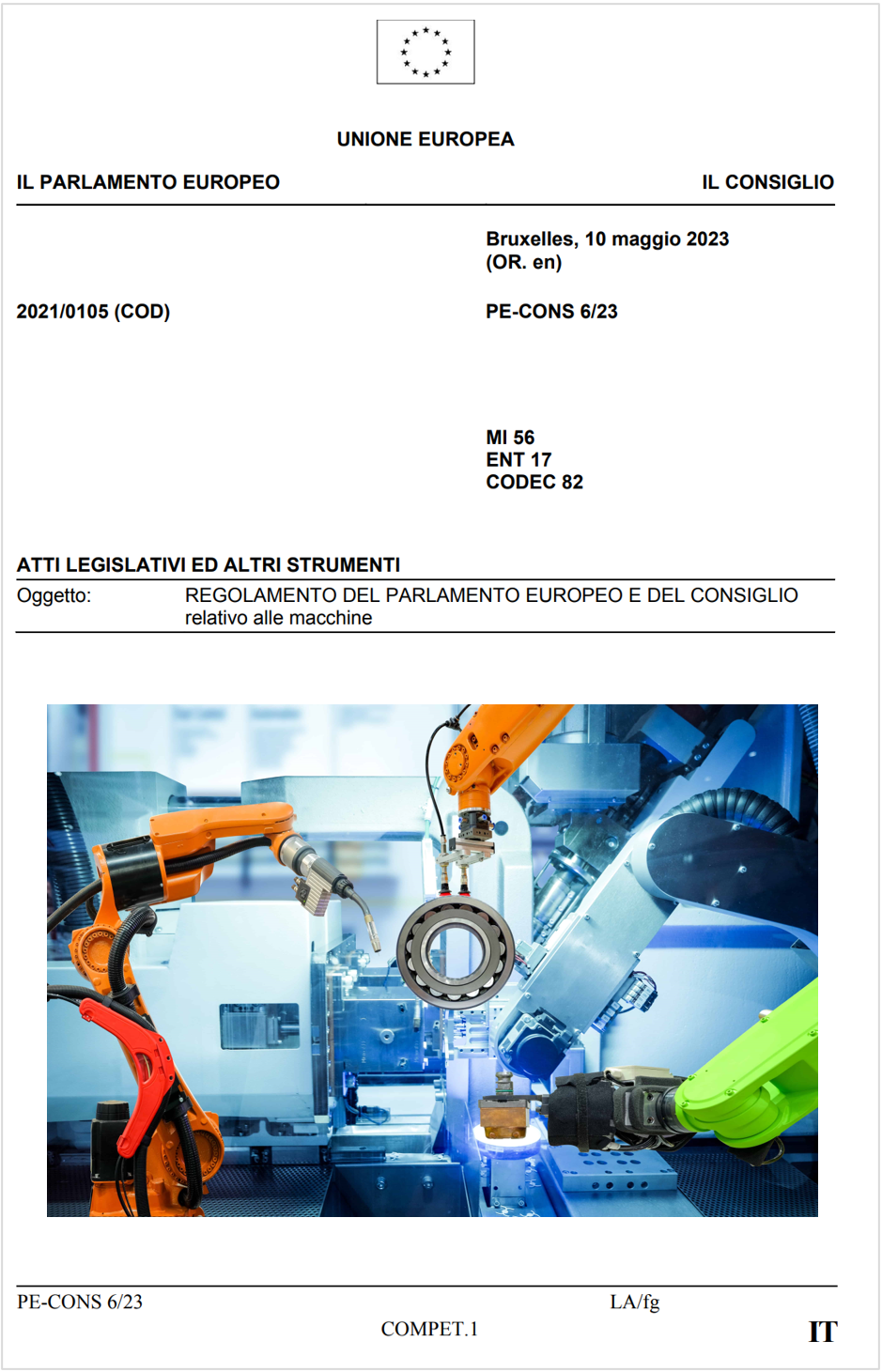
Discussione Consiglio Regolamento macchine - Maggio 2023
ID 19628 | 15.05.2023 / In allegato Draft PE-CONS 6/23 in IT
Progetto di Regolamento del Parlamento Europeo e del Consiglio relativo alle macchine (prima lettura) - Adozione dell'atto legislativo
1. Il 22 aprile 2021 la Commissione ha presentato al Consiglio la sua proposta, basata sull'articolo 114 TFUE.
2. Il Comitato economico e sociale europeo ha formulato il suo parere il 22 settembre 2021.
3. Il 18 aprile 2023 il Parlamento europeo ha adottato la sua posizione in prima lettura sulla proposta della Commissione. L'esito della votazione del Parlamento europeo riflette l'accordo di compromesso raggiunto tra le istituzioni e dovrebbe pertanto essere accettabile per il Consiglio.
4. Consiglio: 10 maggio 2023 - PE-CONS 6/23 Progetto di Regolamento del Parlamento Europeo e del Consiglio relativo alle macchine (prima lettura) - Adozione dell'atto legislativo.
5. 15.05.2023: Dichiarazione della Commissione
Nel valutare i criteri di cui all'articolo 6, paragrafo 4, la Commissione presterà particolare attenzione alle categorie di prodotti per i quali si verifica un numero significativo di incidenti e decessi.
Articolo 6 Categorie di macchine e prodotti correlati elencati nell'allegato I soggetti a procedure specifiche di valutazione della conformità - comma 4
4. La Commissione valuta la gravità del potenziale rischio intrinseco che presenta una categoria di macchine o prodotti correlati al fine di stabilire se aggiungere tale categoria di macchine o prodotti correlati all'allegato I o se eliminarla da tale allegato. Tale valutazione è stabilita sulla base della combinazione della probabilità del verificarsi del danno e della gravità di quest'ultimo.
Nel determinare la probabilità e la gravità del danno, sono presi in considerazione, se del caso, i criteri seguenti:
a) la natura del pericolo intrinseco alla funzione della categoria di macchine o prodotti correlati, tenendo conto dell'uso previsto e di qualsiasi uso scorretto ragionevolmente prevedibile;
b) la gravità del danno che una persona subirebbe, incluso il grado di reversibilità del danno;
c) il numero di persone potenzialmente interessate dal danno;
d) la frequenza e la durata dell'esposizione al pericolo al quale una persona sarebbe esposta nel corso dell'uso previsto o di qualsiasi uso scorretto ragionevolmente prevedibile della categoria di macchine o prodotti correlati;
e) le possibilità di evitare o di limitare il danno;
f) per quanto riguarda i componenti di sicurezza, la probabilità di conseguenze gravi per la sicurezza delle persone esposte al danno in caso di guasto di tali componenti
6. Il Comitato dei Rappresentanti Permanenti è invitato a confermare il proprio accordo e a suggerire al Consiglio di approvare la posizione del Parlamento europeo (PECONS 6/23).
7. Se il Consiglio approva la posizione del Parlamento europeo, l'atto legislativo sarà adottato. Dopo essere stato firmato dai presidenti del Parlamento europeo e del Consiglio, l'atto legislativo sarà pubblicato nella Gazzetta ufficiale dell'Unione europea.
...
Fonte: Consiglio europeo
- Published: 15 May 2023
- Hits: 4788
Posted in News
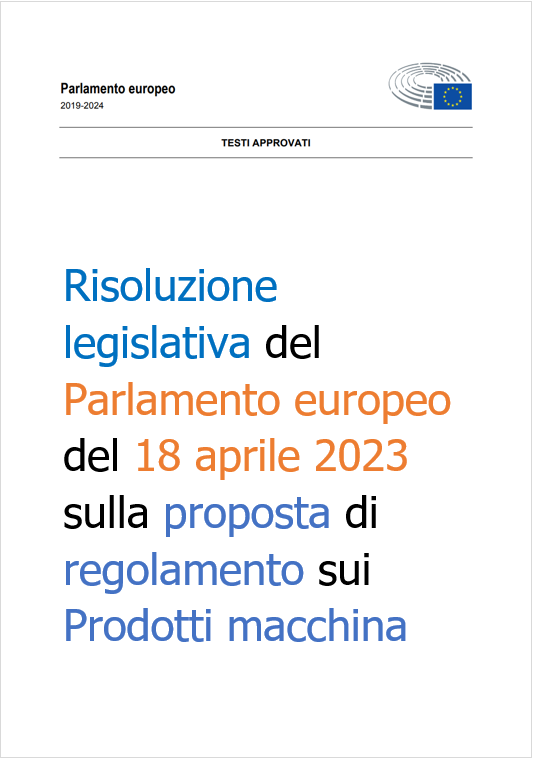
Il Parlamento Europeo adotta il Regolamento Macchine: 18 aprile 2023
Il Parlamento Europeo, con 595 voti a favore, 7 contrari e 30 astenuti, ha adottato, nella seduta del 18 aprile 2023, il nuovo Regolamento Macchine.
Il nuovo Regolamento Macchine dovrebbe essere pubblicato sulla Gazzetta Ufficiale dell’Unione Europea nella prima parte del prossimo mese di luglio: entrata in vigore, quindi, 20 giorni dopo la pubblicazione.
Il nuovo Regolamento Macchine, poi, diverrà applicabile 42 mesi dopo l’entrata in vigore.
- Published: 21 April 2023
- Hits: 7715
Posted in News
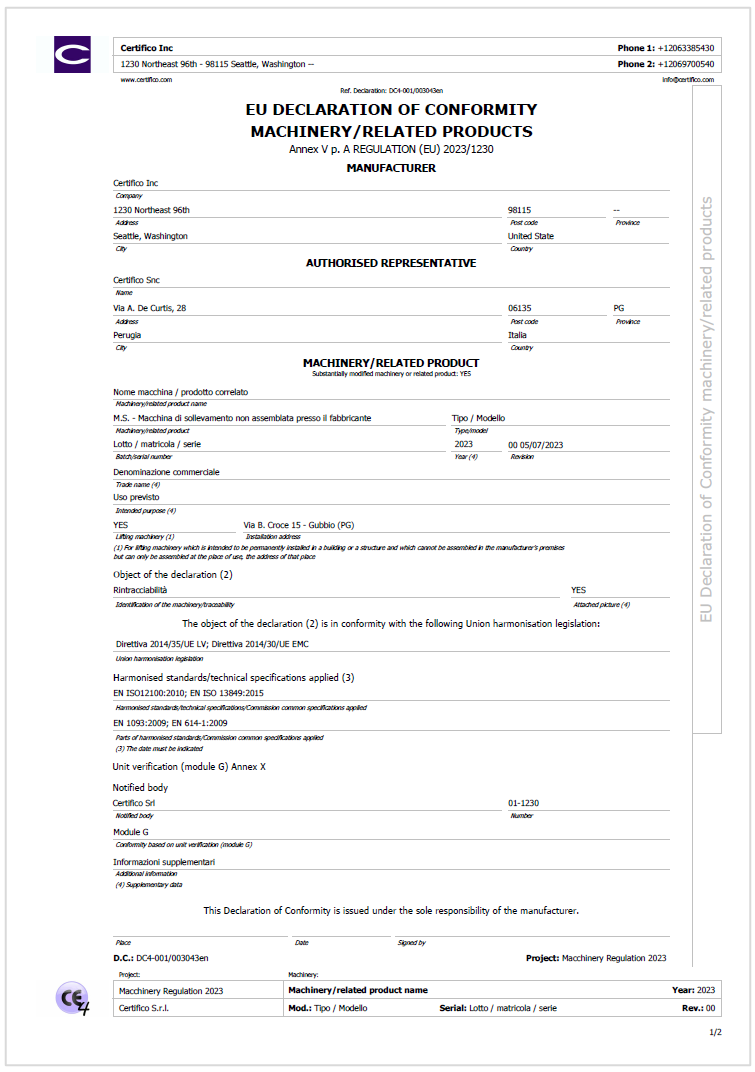
EU Declaration of Conformity Report Machinery Regulation
CEM4 Template
Regulation (EU) 2023/1230 the European Parliament and of the Council of 14 June 2023 on machinery and repealing Directive 2006/42/EC of the European Parliament and of the Council and Council Directive 73/361/EEC. (OJ L 165/1 of 29.06.2023)
_______
ANNEX V EU DECLARATION OF CONFORMITY AND EU DECLARATION OF INCORPORATION
PART A
EU declaration of conformity of machinery and related products No … (1)
The EU declaration of conformity shall contain the following particulars:
1. The machinery or related product (product, type, model, batch or serial number) or substantially modified machinery or related product.
2. Name and address of the manufacturer and, where applicable, its authorised representative.
3. For lifting machinery which is intended to be permanently installed in a building or a structure and which cannot be assembled in the manufacturer’s premises but can only be assembled at the place of use, the address of that place.
4. This declaration of conformity is issued under the sole responsibility of the manufacturer.
5. Object of the declaration (identification of the machinery or related product allowing traceability; where necessary for the identification of the machinery or related product, a colour image of sufficient clarity may be included).
6. The object of the declaration referred to in point 5 is in conformity with the following Union harmonisation legislation.
7. References to the harmonised standards referred to in Article 20(1) or common specifications adopted by the Commission in accordance with Article 20(3) that were applied, including the date of the publication of the reference to harmonised standards in the Official Journal of the European Union or of the common specification, or references to the other technical specifications, including their date, in relation to which conformity is declared. In the event of partial application of harmonised standards or common specifications, the EU declaration of conformity shall specify the parts which were applied.
8. Where applicable, the notified body … (name, number) … performed the EU type-examination (Module B) and issued the EU type-examination certificate … (reference to that certificate), followed by conformity to type based on internal production control (module C) or the conformity based on unit verification (module G) or full quality assurance (module H).
9. Where applicable, the machinery or related product is subject to the conformity assessment procedure based on internal production control (Module A).
10. Additional information:
Signed for and on behalf of: …
(place and date of issue):
(name, function) (signature):
- Published: 16 July 2023
- Hits: 9599
Posted in News
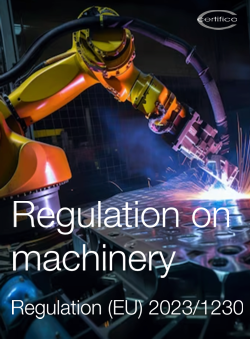
Regulation on machinery | Regulation (EU) 2023/1230 - Consolidated text 2023
ID 19930 | 06.07.2023 / Pdf - epub Format
Regulation (EU) 2023/1230 the European Parliament and of the Council of 14 June 2023 on machinery and repealing Directive 2006/42/EC of the European Parliament and of the Council and Council Directive 73/361/EEC. (OJ L 165/1 of 29.06.2023). In force: 19.07.2023
Download Index Ed. 1.0 2023
Ed. 1.0 2023 - Consolidated text July 2023:
- Regulation (EU) 2023/1230 the European Parliament and of the Council of 14 June 2023 on machinery and repealing Directive 2006/42/EC of the European Parliament and of the Council and Council Directive 73/361/EEC. (OJ L 165/1 of 29.06.2023)
- Corrigendum to Regulation (EU) 2023/1230 of the European Parliament and of the Council of 14 June 2023 on machinery and repealing Directive 2006/42/EC of the European Parliament and of the Council and Council Directive 73/361/EEC (OJ 169/35 of 04.07.2023)
Repeals
Directive 73/361/EEC is repealed.
Directive 2006/42/EC is repealed with effect from 20 January 2027.
Entry into force and application
This Regulation shall enter into force on the twentieth day following that of its publication in the Official Journal of the European Union.
It shall apply from 20 January 2027.
However, the following Articles shall apply from the following dates:
(a) Articles 26 to 42 from 20 January 2024;
(b) Article 50(1) from 20 October 2026;
(c) Article 6(7) and Articles 48 and 52 from 19 July 2023;
(d) Article 6(2) to (6), (8) and (11) and Articles 47 and 53(3) from 20 July 2024.
This Regulation lays down health and safety requirements for the design and construction of machinery, related products and partly completed machinery to allow them to be made available on the market or put into service while ensuring a high level of protection of the health and safety of persons, in particular consumers and professional users, and, where appropriate, of domestic animals and property, and, where applicable, of the environment. It also establishes rules on the free movement of products within the scope of this Regulation in the Union.
The Regulation (EU) 2023/1230 applies to machinery and the following related products:
(a) interchangeable equipment;
(b) safety components;
(c) lifting accessories;
(d) chains, ropes and webbing;
(e) removable mechanical transmission devices.
The Regulation (EU) 2023/1230 also applies to partly completed machinery.
For the purposes of this Regulation, machinery, the related products listed in the first subparagraph and partly completed machinery shall together be referred to as ‘products within the scope of this Regulation’.
The Regulation (EU) 2023/1230 does not apply to:
(a) safety components that are intended to be used as spare parts to replace identical components and are supplied by the manufacturer of the original machinery, related product or partly completed machinery;
(b) specific equipment for use in fairgrounds or amusement parks;
(c) machinery and related products specially designed for use within or used in a nuclear installation and whose conformity with this Regulation may undermine the nuclear safety of that installation;
(d) weapons, including firearms;
(e) means of transport by air, on water and on rail networks except for machinery mounted on those means of transport;
(f) aeronautical products, parts and equipment that fall within the scope of Regulation (EU) 2018/1139 of the European Parliament and of the Council (21) and the definition of machinery under this Regulation, insofar as Regulation (EU) 2018/1139 covers the relevant essential health and safety requirements set out in this Regulation;
(g) motor vehicles and their trailers, as well as systems, components, separate technical units, parts and equipment designed and constructed for such vehicles, which fall within the scope of Regulation (EU) 2018/858, except for machinery mounted on those vehicles;
(h) two- or three-wheel vehicles and quadricycles, as well as systems, components, separate technical units, parts and equipment designed and constructed for such vehicles, that fall within the scope of Regulation (EU) No 168/2013, except for machinery mounted on those vehicles;
(i) agricultural and forestry tractors, as well as systems, components, separate technical units, parts and equipment designed and constructed for such tractors, that fall within the scope of Regulation (EU) No 167/2013, except for machinery mounted on those tractors;
(j) motor vehicles exclusively intended for competition;
(k) seagoing vessels and mobile offshore units and machinery installed on board such vessels or units;
(l) machinery or related products specially designed and constructed for military or police purposes;
(m) machinery or related products specially designed and constructed for research purposes for temporary use in laboratories;
(n) mine winding gear;
(o) machinery or related products intended to move performers during artistic performances;
(p) the following electrical and electronic products, insofar as they fall within the scope of Directive 2014/35/EU or of Directive 2014/53/EU:
(i) household appliances intended for domestic use which are not electrically operated furniture;
(ii) audio and video equipment;
(iii) information technology equipment;
(iv) ordinary office machinery, except additive printing machinery for producing three-dimensional products;
(v) low-voltage switchgear and control gear;
(vi) electric motors;
(q) the following high-voltage electrical products:
(i) switchgear and control gear;
(ii) transformers.
______
Ed: 1.0 July 2023
Operating Systems: iOS/Android
Publication Date: 06/7/2023
Author: Dr. Eng. Marco Maccarelli
Publisher: Certifico s.r.l.
ISBN: 978-88-98550-11-1
Download PDF
Download Google Play
Download Apple Books
- Published: 06 July 2023
- Hits: 11055
Posted in News
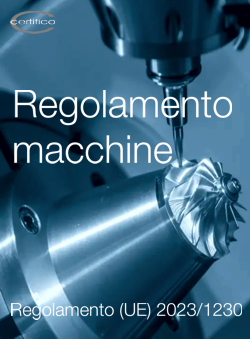
Regolamento macchine | Regolamento (UE) 2023/1230
ID 19804 | Ed. 3.0 del 09.11.2024
Disponibile in formato pdf /epub navigabile e stampabile/copiabile il testo consolidato 2024 del Regolamento (UE) 2023/1230 del Parlamento europeo e del Consiglio del 14 giugno 2023 relativo alle macchine e che abroga la direttiva 2006/42/CEdel Parlamento euroeo e del Consiglio e la direttiva 73/361/CEE del Consiglio (GU n. 165/1 del 29.06.2023) contenente la rettifica del regolamento (UE) 2023/1230 del 04 luglio 2023. (GU L 169/35 del 4.7.2023).
Download Indice Ed. 3.0 2024
Ed. 3.0 del 09 Novembre 2024
- Regolamento (UE) 2024/2748 del Parlamento europeo e del Consiglio, del 9 ottobre 2024, che modifica i regolamenti (UE) n. 305/2011, (UE) 2016/424, (UE) 2016/425, (UE) 2016/426, (UE) 2023/988 e (EU) 2023/1230 per quanto riguarda le procedure di emergenza per la valutazione della conformità, la presunzione di conformità, l’adozione di specifiche comuni e la vigilanza del mercato nel contesto di un’emergenza nel mercato interno. (GU L 2024/2748 dell'8.11.2024)
Modifiche:
Articolo 3 Definizioni. Inserita nota (N)
Articolo 25 bis Applicazione di procedure di emergenza. Inserita nota (N)
Articolo 25 ter Assegnazione della priorità alla valutazione della conformità della macchina e dei prodotti correlati designati come beni rilevanti per la crisi. Inserita nota (N)
Articolo 25 quater Deroga alle procedure di valutazione della conformità che richiedono il coinvolgimento obbligatorio di un organismo notificato. Inserita nota (N)
Articolo 25 quinquies Presunzione di conformità sulla base di norme e specifiche comuni. Inserita nota (N)
Articolo 25 sexies Assegnazione della priorità alle attività di vigilanza del mercato e mutua assistenza tra le autorità. Inserita nota (N)
Ed. 2.0 del 04 Luglio 2023
- Rettifica del regolamento (UE) 2023/1230 del Parlamento europeo e del Consiglio, del 14 giugno 2023, relativo alle macchine e che abroga la direttiva 2006/42/CE del Parlamento europeo e del Consiglio e la direttiva 73/361/CEE del Consiglio. (GU L 169/35 del 4.7.2023)
Modifiche:
Art. 6 comma 9 e 10. Inserita nota (N)
Art. 47 comma 2. Inserita nota (N)
Art. 50 comma 2. Inserita nota (N)
Art. 51 comma 2. Inserita nota (N)
Art. 52 comma 1. Inserita nota (N)
Art. 53 comma 1 e 3. Inserita nota (N)
Art. 54. Inserita nota (N)
...
Testo nativo
Regolamento (UE) 2023/1230 del Parlamento europeo e del Consiglio del 14 giugno 2023 relativo alle macchine e che abroga la direttiva 2006/42/CE del Parlamento europeo e del Consiglio e la direttiva 73/361/CEE del Consiglio. (GU n. 163 del 29.06.2023).
Modifiche:
- Regolamento (UE) 2024/2748 del Parlamento europeo e del Consiglio, del 9 ottobre 2024 (GU L 2024/2748 dell'8.11.2024)
Rettifiche:
- Rettifica del regolamento (UE) 2023/1230 (GU L 169/35 del 4.7.2023)
Entrata in vigore: 19.07.2023
Applicazione dal 20.01.2027. Tuttavia, gli articoli seguenti si applicano a decorrere dalle date seguenti:
- gli articoli da 26 a 42 si applicano a decorrere dal 20.01.2024
- l'articolo 50, paragrafo 1, si applica a decorrere dal 20.10.2026
- l'articolo 6, paragrafo 7, e gli articoli 48 e 52 si applicano a decorrere dal 19.07.2023
- l'articolo 6, paragrafi da 2 a 6, paragrafo 8 e paragrafo 11, l'articolo 47 e l'articolo 53, paragrafo 3, si applicano a decorrere dal 20.07.2024
Il Regolamento (UE) 2023/1230 stabilisce i requisiti di sicurezza e di tutela della salute per la progettazione e la costruzione di macchine, prodotti correlati e quasi-macchine al fine di consentire la loro messa a disposizione sul mercato o la loro messa in servizio, garantendo al contempo un livello elevato di tutela della salute e di sicurezza delle persone, in particolare dei consumatori e degli utilizzatori professionali, e, ove opportuno, degli animali domestici nonché di tutela dei beni e, se del caso, dell'ambiente. Esso stabilisce inoltre norme concernenti la libera circolazione dei prodotti rientranti nell'ambito di applicazione del presente regolamento nell'Unione.
Il Regolamento (UE) 2023/1230 si applica alle macchine e ai prodotti correlati seguenti:
a) attrezzature intercambiabili;
b) componenti di sicurezza;
c) accessori di sollevamento;
d) catene, funi e cinghie;
e) dispositivi amovibili di trasmissione meccanica.
Il Regolamento (UE) 2023/1230 si applica altresì alle quasi-macchine.
Ai fini del Regolamento (UE) 2023/1230, le macchine, i prodotti correlati elencati nel primo comma e le quasi-macchine sono indicati come "prodotti rientranti nell'ambito di applicazione del presente regolamento".
Il Regolamento (UE) 2023/1230 non si applica a quanto segue:
a) i componenti di sicurezza destinati ad essere utilizzati come pezzi di ricambio in sostituzione di componenti identici e forniti dal fabbricante della macchina originaria, del prodotto correlato o della quasi-macchina;
b) le attrezzature specifiche per parchi giochi o di divertimento;
c) le macchine e i prodotti correlati specificamente progettati per essere utilizzati o che sono utilizzati all'interno di un impianto nucleare e la cui conformità al presente regolamento può compromettere la sicurezza nucleare dell'impianto in questione;
d) le armi, incluse le armi da fuoco;
e) i mezzi di trasporto per via aerea, per via navigabile o su rete ferroviaria, fatta eccezione per le macchine installate su tali mezzi di trasporto;
f) i prodotti aeronautici, le parti e gli equipaggiamenti che rientrano nell'ambito di applicazione del regolamento (UE) 2018/1139 del Parlamento europeo e del Consiglio e nella definizione di macchine ai sensi del presente regolamento, nella misura in cui il regolamento (UE) 2018/1139 disciplina i pertinenti requisiti essenziali di sicurezza e di tutela della salute stabiliti nel presente regolamento;
g) i veicoli a motore e i relativi rimorchi, nonché i sistemi, i componenti, le unità tecniche separate, le parti e le attrezzature progettate e costruite per tali veicoli, che rientrano nell'ambito di applicazione del regolamento (UE) 2018/858, fatta eccezione per le macchine installate su tali veicoli;
h) i veicoli a due o tre ruote e i quadricicli, nonché i sistemi, i componenti, le entità tecniche indipendenti, le parti e gli equipaggiamenti progettati e costruiti per tali veicoli, che rientrano nell'ambito di applicazione del regolamento (UE) n. 168/2013, fatta eccezione per le macchine installate su tali veicoli;
i) i trattori agricoli e forestali, nonché i sistemi, i componenti, le entità tecniche indipendenti, le parti e gli equipaggiamenti progettati e costruiti per tali trattori, che rientrano nell'ambito di applicazione del regolamento (UE) n. 167/2013, fatta eccezione per le macchine installate su tali trattori;
j) i veicoli a motore esclusivamente da competizione;
k) le navi marittime e le unità mobili off-shore, nonché le macchine installate a bordo di tali navi o unità;
l) le macchine o i prodotti correlati appositamente progettati e costruiti a fini militari o di mantenimento dell'ordine pubblico;
m) le macchine o i prodotti correlati appositamente progettati e costruiti a fini di ricerca per essere temporaneamente utilizzati nei laboratori;
n) gli ascensori utilizzati nei pozzi delle miniere;
o) le macchine o i prodotti correlati adibiti allo spostamento di artisti durante le rappresentazioni;
p) i seguenti prodotti elettrici ed elettronici, nella misura in cui rientrano nell'ambito della direttiva 2014/35/UE o della direttiva 2014/53/UE:
i) elettrodomestici destinati a uso domestico che non sono mobili azionati elettricamente;
ii) apparecchiature audio e video;
iii) apparecchiature nel settore delle tecnologie dell'informazione;
iv) macchine ordinarie da ufficio, fatta eccezione per le macchine per la stampa additiva per realizzare prodotti tridimensionali;
v) apparecchiature di collegamento e di controllo a bassa tensione;
vi) motori elettrici;
q) i prodotti elettrici ad alta tensione seguenti:
i) apparecchiature di collegamento e di controllo;
ii) trasformatori.
[...]
Download Indice Ed. 2.0 2023
Premessa
Capo I Disposizioni generali
Articolo 1. Oggetto
Articolo 2. Ambito di applicazione
Articolo 3. Definizioni
Articolo 4. Libera circolazione
Articolo 5. Protezione delle persone durante l'installazione e l'uso di macchine o prodotti correlati
Articolo 6. Categorie di macchine e prodotti correlati elencati nell'allegato I soggetti a procedure specifiche di valutazione della conformità
Articolo 7. Componenti di sicurezza
Articolo 8. Requisiti essenziali di sicurezza e di tutela della salute dei prodotti rientranti nell'ambito di applicazione del presente regolamento
Articolo 9. Normativa specifica di armonizzazione dell'Unione
Capo II. Obblighi degli operatori economici
Articolo 10 Obblighi dei fabbricanti di macchine e di prodotti correlati
Articolo 11. Obblighi dei fabbricanti di quasi-macchine
Articolo 12. Mandatari
Articolo 13. Obblighi degli importatori di macchine e di prodotti correlati
Articolo 14. Obblighi degli importatori di quasi-macchine
Articolo 15. Obblighi dei distributori di macchine e di prodotti correlati
Articolo 16. Obblighi dei distributori di quasi-macchine
Articolo 17. Casi in cui gli obblighi dei fabbricanti si applicano agli importatori e ai distributori
Articolo 18. Altri casi in cui si applicano gli obblighi dei fabbricanti
Articolo 19. Identificazione degli operatori economici
Capo III. Conformità dei prodotti rientranti nell'ambito di applicazione del presente regolamento
Articolo 20. Presunzione di conformità dei prodotti rientranti nell'ambito di applicazione del presente regolamento
Articolo 21. Dichiarazione di conformità UE per le macchine e i prodotti correlati
Articolo 22. Dichiarazione di incorporazione UE di quasi-macchine
Articolo 23. Principi generali della marcatura CE
Articolo 24. Norme per l'apposizione della marcatura CE alle macchine e ai prodotti correlati
Capo IV. Valutazione della conformità
Articolo 25. Procedure di valutazione della conformità per le macchine e i prodotti correlati
Capo V. Notifica degli organismi di valutazione della conformità
Articolo 26. Notifica
Articolo 27. Autorità di notifica
Articolo 28. Prescrizioni relative alle autorità di notifica
Articolo 29. Obbligo di informazione delle autorità di notifica
Articolo 30. Prescrizioni relative agli organismi notificati
Articolo 31. Presunzione di conformità degli organismi notificati
Articolo 32. Ricorso a subappaltatori e affiliati da parte degli organismi notificati
Articolo 33. Domanda di notifica
Articolo 34. Procedura di notifica
Articolo 35. Numeri di identificazione ed elenchi degli organismi notificati
Articolo 36. Modifiche delle notifiche
Articolo 37. Contestazione della competenza degli organismi notificati
Articolo 38. Obblighi operativi degli organismi notificati
Articolo 39. Ricorsi contro le decisioni degli organismi notificati
Articolo 40. Obbligo di informazione a carico degli organismi notificati
Articolo 41. Scambio di esperienze
Articolo 42. Coordinamento degli organismi notificati
Capo VI. Vigilanza del mercato dell'Unione e procedure di salvaguardia dell'Unione
Articolo 43 Procedura a livello nazionale per i prodotti rientranti nell'ambito di applicazione del presente regolamento che presentano rischi
Articolo 44. Procedura di salvaguardia dell'Unione
Articolo 45. Prodotti conformi rientranti nell'ambito di applicazione del presente regolamento che presentano un rischio
Articolo 46. Non conformità formale
Capo VII. Delega di poteri e procedura di comitato
Articolo 47 Esercizio della delega
Articolo 48. Procedura di comitato
Capo VIII. Riservatezza e sanzioni
Articolo 49 Riservatezza
Articolo 50. Sanzioni
Capo IX. Disposizioni transitorie e finali
Articolo 51. Abrogazioni
Articolo 52. Disposizioni transitorie
Articolo 52. Procedure di valutazione della conformità
Articolo 53. Valutazione e riesame
Articolo 54. Entrata in vigore e applicazione
Allegati
Allegato I Categorie di macchine o prodotti correlati per le quali va applicata una delle procedure di cui all'articolo 25, paragrafi 2 e 3
Allegato II Elenco indicativo di componenti di sicurezza
Allegato III Requisiti essenziali di sicurezza e di tutela della salute relativi alla progettazione e alla costruzione di macchine o prodotti correlati
Allegato IV Documentazione tecnica
Allegato V Dichiarazione di conformità UE e dichiarazione di incorporazione UE
Allegato VI Controllo interno della produzione
Allegato VII Esame UE del tipo
Allegato VIII Conformità al tipo basata sul controllo interno della produzione
Allegato IX Conformità basata sulla garanzia qualità totale
Allegato X Conformità basata sulla verifica dell'unità
Allegato XI Istruzioni per l'assemblaggio delle quasi-macchine
Allegato XII Tavola di concordanza
...
Formato: pdf
Pagine: +144
Ed.: 2.0 2023
Pubblicato: 04/07/2023
Autore: Ing. Marco Maccarelli
Editore: Certifico s.r.l.
Lingue: Italiano
ISBN: 9788898550135
Formato PDF: Riservato Abbonati Direttiva macchine/4X/Full/Full Plus
Vedi PDF Certifico
Vedi Google Play
Vedi Apple Books
- Published: 29 June 2023
- Hits: 8105
Posted in News
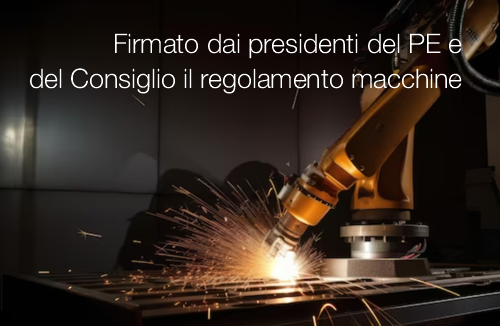
Regolamento macchine: firmato presidenti del PE e del Consiglio il 14 giugno - previsto in GU il 29 giugno 2023
Il nuovo regolamento macchine è stato firmato dai presidenti del Parlamento europeo e del Consiglio il 14 giugno 2023 ed è attesa l'imminente pubblicazione in Gazzetta ufficiale dell'Unione europea, prevista per il 29 giugno p.v.
Una volta pubblicato in GU il regolamento entrerà in vigore il ventesimo giorno successivo alla pubblicazione, ovvero il 19 luglio 2023. Gli Stati membri e gli operatori economici avranno 42 mesi di tempo prima che vengano applicate le norme del nuovo regolamento.
La direttiva 2006/42/CE verrà abrogata a decorrere da gennaio 2027.
Il nuovo testo armonizza i requisiti essenziali in termini di sicurezza e di tutela della salute applicabili alle macchine nell'UE, promuove la libera circolazione delle macchine e assicura un livello elevato di sicurezza per lavoratori e cittadini.
Le norme aggiornate consentiranno all'industria europea di operare nell'ambito di un quadro giuridico nuovo e migliorato. Garantiranno un elevato livello di protezione ai nostri lavoratori e ai nostri cittadini, migliorando nel contempo la competitività e la reputazione delle macchine nell'UE.
Il regolamento firmato il 14 giugno 2023, rende obbligatoria una valutazione della conformità da parte di terzi per sei categorie di macchine che presentano rischi elevati.
Le informazioni sulla sicurezza dovranno essere fornite per tutti i prodotti ma, in linea con la transizione digitale, il regolamento stabilisce che le istruzioni digitali saranno l'opzione predefinita. Le istruzioni cartacee rimarranno un'opzione per i clienti che ne faranno richiesta.
La direttiva "macchine" del 2006 era uno dei principali atti legislativi sull'armonizzazione dei requisiti essenziali in termini di sicurezza e di tutela della salute applicabili alle macchine a livello dell'UE. Il nuovo regolamento adottato istituirà un quadro giuridico per l'immissione sul mercato dell'Unione di macchine sicure e coprirà i nuovi rischi connessi alle tecnologie emergenti. Il nuovo testo garantisce inoltre la certezza del diritto chiarendo l'ambito di applicazione del regolamento, nel quale rientrano ad esempio i veicoli di piccole dimensioni utilizzati per il trasporto personale e i veicoli elettrici leggeri come gli scooter e le biciclette, in quanto sono ampiamente utilizzati e potrebbero essere potenzialmente pericolosi per i loro utilizzatori.
...
Fonte: UE
- Published: 22 June 2023
- Hits: 6440
Posted in News
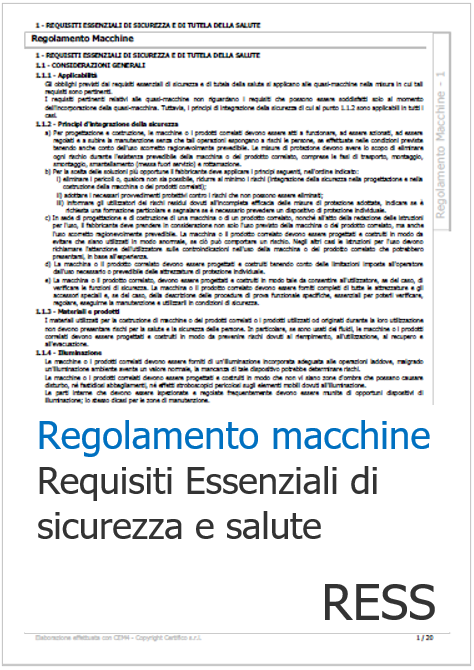
Regolamento macchine: i Requisiti Essenziali di sicurezza e salute RESS / Estratto template CEM4 - Draft 14.06.2023
Proponiamo Draft 14.06.2023 dell'elenco dei RESS (Allegato III) di cui al Regolamento macchine 2023 elaborato template CEM4, su testo Regolamento macchine approvato definitivamente dal Consiglio PE-CONS 6-23 in data 23.05.2023 - non in GU.
Attenzione:
DRAFT 14.06.2023 / non definitivo, si attende pubblicazione Regolamento in GU - Template Certifico / CEM4
ALLEGATO III Requisiti essenziali di sicurezza e di tutela della salute relativi alla progettazione e alla costruzione di macchine o prodotti correlati
Parte A DEFINIZIONI
Ai fini del presente allegato si intende per:
a) "pericolo": una potenziale fonte di lesione o danno alla salute;
b) "zona pericolosa": qualsiasi zona all'interno e/o in prossimità di una macchina o di un prodotto correlato in cui la presenza di una persona costituisca un rischio per la sicurezza o la salute di detta persona;
c) "persona esposta": qualsiasi persona che si trovi interamente o in parte in una zona pericolosa;
d) "operatore": la persona o le persone incaricate di installare, di far funzionare, di regolare, di pulire, di riparare e di spostare una macchina o un prodotto correlato o di eseguirne la manutenzione;
e) "rischio", combinazione della probabilità e della gravità di una lesione o di un danno per la salute che possano insorgere in una situazione pericolosa;
f) "riparo": elemento di una macchina o di un prodotto correlato utilizzato specificamente per garantire la protezione tramite una barriera materiale;
g) "dispositivo di protezione": dispositivo (diverso da un riparo) che riduce il rischio, da solo o associato ad un riparo;
h) "uso previsto": l'uso di una macchina o di un prodotto correlato conformemente alle informazioni fornite nelle istruzioni per l'uso;
i) "uso scorretto ragionevolmente prevedibile": l'uso di una macchina o di un prodotto correlato in un modo diverso da quello indicato nelle istruzioni per l'uso, ma che può derivare dal comportamento umano facilmente prevedibile.
Parte B PRINCIPI GENERALI
1. Il fabbricante di una macchina o di un prodotto correlato deve provvedere affinché sia effettuata una valutazione del rischio per stabilire i requisiti essenziali di sicurezza e di tutela della salute che concernono la macchina o il prodotto correlato. La macchina o il prodotto correlato devono inoltre essere progettati e costruiti per eliminare i rischi o, ove non sia possibile, ridurre al minimo tutti i rischi pertinenti, tenendo conto dei risultati della valutazione del rischio.
Con il processo iterativo della valutazione del rischio e della riduzione del rischio di cui al primo comma, il fabbricante:
a) stabilisce i limiti della macchina o del prodotto correlato, il che comprende l'uso previsto e l'uso scorretto ragionevolmente prevedibile;
b) individua i pericoli cui può dare origine la macchina o il prodotto correlato e le situazioni pericolose che ne derivano;
c) stima i rischi, tenendo conto della gravità dell'eventuale lesione o danno alla salute e della probabilità che si verifichi;
d) valuta i rischi al fine di stabilire se sia richiesta una riduzione del rischio conformemente all'obiettivo del presente regolamento;
e) elimina i pericoli o riduce i rischi che ne derivano, applicando le misure di protezione nell'ordine indicato nel punto 1.1.2, lettera b).
La valutazione del rischio e la riduzione del rischio includono i pericoli che possono manifestarsi durante il ciclo di vita della macchina o del prodotto correlato prevedibili al momento dell'immissione della macchina o del prodotto correlato sul mercato come un'evoluzione prevista del suo comportamento o della sua logica integralmente o parzialmente autoevolutivi in ragione del fatto che tale macchina o prodotto correlato è progettato per funzionare con livelli variabili di autonomia. La valutazione del rischio e la riduzione del rischio comprendono i rischi derivanti dalle interazioni tra macchine che per raggiungere uno stesso risultato sono disposte e comandate in modo da avere un funzionamento solidale, formando così una macchina come definita all'articolo 3, punto 1, lettera d).
2. Gli obblighi previsti dai requisiti essenziali di sicurezza e di tutela della salute si applicano soltanto se esiste il pericolo corrispondente per la macchina o il prodotto correlato in questione, allorché viene utilizzato nelle condizioni previste dal fabbricante o in condizioni anormali prevedibili.
Tuttavia, il principio di integrazione della sicurezza di cui al punto 1.1.2 e gli obblighi relativi alla marcatura delle macchine o dei prodotti correlati di cui al punto 1.7.3 e alle istruzioni per l’uso di cui al punto 1.7.4 si applicano in ogni caso.
3. I requisiti essenziali di sicurezza e di tutela della salute elencati nel presente allegato sono inderogabili; tuttavia, tenuto conto dello stato dell’arte, gli obiettivi da essi prefissi possono non essere raggiunti. In tal caso, la macchina o il prodotto correlato, per quanto possibile, deve essere progettato e costruito per tendere verso tali obiettivi.
4. Il presente allegato si articola in sei capi. Il primo capo ha una portata generale e si applica a tutte le macchine o prodotti correlati. Gli altri capi si riferiscono a taluni tipi di pericoli più specifici.
Tuttavia, è indispensabile esaminare il presente allegato in tutte le sue parti, al fine di essere certi di soddisfare tutti i pertinenti requisiti essenziali di sicurezza e di tutela della salute.
Nel progettare la macchina o un prodotto correlato si tiene conto dei requisiti contenuti nel primo capo e di quelli elencati in uno o più degli altri capi, in funzione dei risultati della valutazione del rischio condotta in conformità del punto 1 dei presenti principi generali.
I requisiti essenziali di sicurezza e di tutela della salute per la tutela dell'ambiente sono applicabili unicamente alle macchine o ai prodotti correlati a di cui al punto 2.4.
5. I presenti principi generali si applicano alla valutazione del rischio effettuata dal fabbricante di quasi-macchine.
1. REQUISITI ESSENZIALI DI SICUREZZA E DI TUTELA DELLA SALUTE
2. REQUISITI ESSENZIALI SUPPLEMENTARI DI SICUREZZA E DI TUTELA DELLA SALUTE PER TALUNE CATEGORIE DI MACCHINE E DI PRODOTTI CORRELATI
2.1. MACCHINE E PRODOTTI CORRELATI ALIMENTARI E MACCHINE E PRODOTTI CORRELATI PER PRODOTTI COSMETICI O FARMACEUTICI
2.2. MACCHINE O PRODOTTI CORRELATI PORTATILI TENUTI O CONDOTTI A MANO
2.3. MACCHINE O PRODOTTI CORRELATI PER LA LAVORAZIONE DEL LEGNO E DI MATERIE CON CARATTERISTICHE FISICHE SIMILI
2.4. MACCHINE O PRODOTTI CORRELATI PER L'APPLICAZIONE DI PRODOTTI FITOSANITARI
3. REQUISITI ESSENZIALI SUPPLEMENTARI DI SICUREZZA E DI TUTELA DELLA SALUTE PER OVVIARE AI RISCHI DOVUTI ALLA MOBILITÀ DELLE MACCHINE O DEI PRODOTTI CORRELATI
4. REQUISITI ESSENZIALI SUPPLEMENTARI DI SICUREZZA E DI TUTELA DELLA SALUTE PER PREVENIRE I RISCHI DOVUTI AD OPERAZIONI DI SOLLEVAMENTO
5. REQUISITI ESSENZIALI SUPPLEMENTARI DI SICUREZZA E DI TUTELA DELLA SALUTE PER LE MACCHINE O I PRODOTTI CORRELATI DESTINATI AD ESSERE UTILIZZATI NEI LAVORI SOTTERRANEI
6. REQUISITI ESSENZIALI SUPPLEMENTARI DI SICUREZZA E DI TUTELA DELLA SALUTE PER LE MACCHINE O I PRODOTTI CORRELATI CHE PRESENTANO RISCHI PARTICOLARI DOVUTI AL SOLLEVAMENTO DI PERSONE
Considerando 48
(49) I requisiti essenziali di sicurezza e di tutela della salute dovrebbero essere soddisfatti al fine di garantire che il prodotto rientrante nell'ambito di applicazione del presente regolamento sia sicuro. Tali requisiti dovrebbero essere applicati con discernimento, tenendo conto dello stato dell'arte al momento della costruzione e delle esigenze tecniche ed economiche.
Articolo 3 Definizioni
14) "requisiti essenziali di sicurezza e di tutela della salute": le disposizioni obbligatorie, di cui all'allegato III, relative alla progettazione e alla costruzione di prodotti rientranti nell'ambito di applicazione del presente regolamento, intese ad assicurare un livello elevato di tutela della salute e di sicurezza delle persone e, ove opportuno, degli animali domestici nonché di tutela dei beni e, se del caso, dell'ambiente.
- Published: 14 June 2023
- Hits: 5917
Posted in News
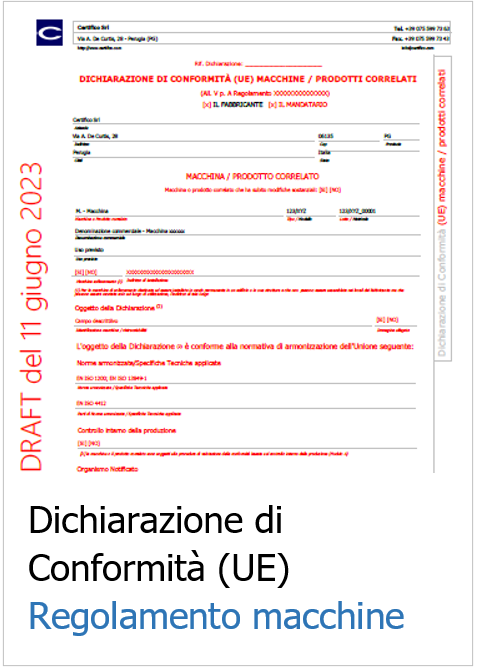
Modello di Dichiarazione di Conformità (UE) Regolamento macchine / Template CEM4 - Draft 11 giugno 2023
Attenzione elaborato su Proposta definitiva approvata Consiglio 23.05.2023 - non in GU.
Proponiamo Draft 11.06.2023 di Modello di Dichiarazione di Conformità (UE) Regolamento macchine 2023 elaborato template CEM4, su testo Regolamento macchine approvato definitivamente dal Consiglio PE-CONS 6-23 in data 23.05.2023 non in GU.
Attenzione:
DRAFT 11.06.2023 / non definitivo, si attende pubblicazione Regolamento in GU - Template Certifico / CEM4 - novità in rosso.
ALLEGATO V
DICHIARAZIONE DI CONFORMITÀ UE
Parte A
DICHIARAZIONE DI CONFORMITÀ UE DI MACCHINE E PRODOTTI CORRELATI n.…(1)
La dichiarazione di conformità UE deve riportare le indicazioni seguenti:
1. Macchina o prodotto correlato (prodotto, tipo, modello, lotto o numero di serie) o macchina o prodotto correlato che ha subito modifiche sostanziali.
2. Nome e indirizzo del fabbricante e, se del caso, del suo mandatario.
3. Per le macchine di sollevamento destinate ad essere installate in modo permanente in un edificio o in una struttura e che non possono essere assemblate nei locali del
fabbricante ma che possono essere montate solo sul luogo di utilizzazione, l'indirizzo di tale luogo.
4. La presente dichiarazione di conformità è rilasciata sotto l'esclusiva responsabilità del fabbricante.
5. Oggetto della dichiarazione (identificazione della macchina o del prodotto correlato che ne consenta la rintracciabilità; se necessario per l'identificazione della macchina
o del prodotto correlato, si può includere un'immagine a colori sufficientemente chiara).
6. L'oggetto della dichiarazione di cui al punto 5 è conforme alla normativa di armonizzazione dell'Unione seguente.
7. Riferimenti alle norme armonizzate di cui all'articolo 20, paragrafo 1, o alle specifiche comuni adottate dalla Commissione conformemente all'articolo 20, paragrafo 3, che sono state applicate, compresa la data della pubblicazione del riferimento alle norme armonizzate nella Gazzetta ufficiale dell’Unione europea o della specifica comune, oppure riferimenti ad altre specifiche tecniche, compresa la data, in relazione alla quale si dichiara la conformità. In caso di applicazione parziale delle norme armonizzate o ndelle specifiche comuni la dichiarazione UE di conformità deve specificare le parti che sono state applicate.
8. Laddove applicabile, l'organismo notificato... (nome, numero)... ha effettuato l'esame UE del tipo (modulo B) e ha emesso il certificato di esame UE del tipo... (riferimento a tale certificato), seguito dalla conformità al tipo basata sul controllo interno della produzione (modulo C) o la conformità basata sulla verifica di un unico prodotto (modulo G) o sulla garanzia qualità totale (modulo H).
9. Laddove applicabile, la macchina o il prodotto correlato sono soggetti alla procedura di valutazione della conformità basata sul controllo interno della produzione (modulo A).
10. Informazioni supplementari:
Firmato a nome e per conto di: …
(luogo e data del rilascio):
(nome e cognome, funzione) (firma):
(1) L'assegnazione di un numero, da parte del fabbricante, alla dichiarazione di conformità è opzionale.
Prodotti correlati / Nota
Articolo 2 Ambito di applicazione
1. Il presente regolamento si applica alle macchine e ai prodotti correlati seguenti (1):
a) attrezzature intercambiabili;
b) componenti di sicurezza;
c) accessori di sollevamento;
d) catene, funi e cinghie;
e) dispositivi amovibili di trasmissione meccanica.
(1) Considerando (15)
Al fine di garantire che l'ambito di applicazione del presente regolamento sia sufficientemente chiaro, è opportuno operare una distinzione tra macchine, prodotti correlati e quasi-macchine. Inoltre, i prodotti correlati dovrebbero essere intesi come comprendenti attrezzature intercambiabili, componenti di sicurezza, accessori di sollevamento, catene, funi e cinghie, nonché dispositivi amovibili di trasmissione meccanica, che sono tutti prodotti rientranti nell'ambito di applicazione del presente regolamento.
- Published: 08 June 2023
- Hits: 8797
Posted in News
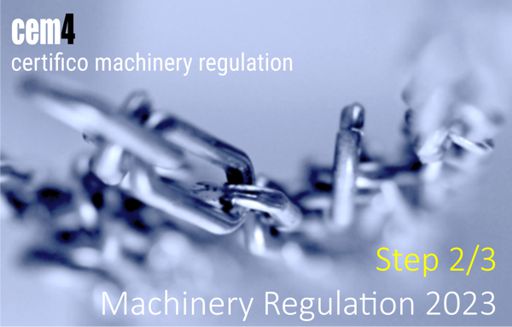
CEM4 May 2023 Update (Step 2/3 Machinery Regulation 2023)
30 May 2023
From step 2/3 of the planned roadmap, CEM4 is ready to be updated to the new 2023 Machinery Regulation which will take place when it is published.
Dear Customers, up to date with the software update, will receive the update step 3/3 Machinery Regulation 2023 in the months of June/July at no additional cost.
- Published: 30 May 2023
- Hits: 5146
Posted in News
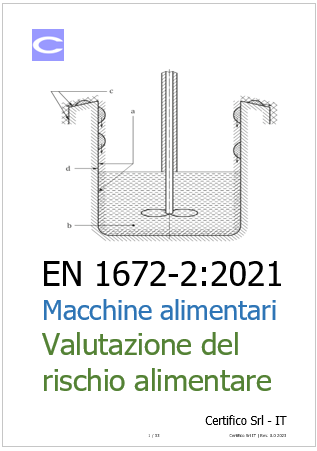
UNI EN 1672-2:2021 Macchine per l’industria alimentare / Valutazione del rischio alimentare
ID 19636 | 16.05.2023
Il Documento, estratto dalla norma UNI EN 1672-2:2021, tratta dei requisiti di igiene delle macchine alimentari con:
- RESS / EN 1672-2 applicabili alle macchine alimentari
- Esempi di gruppi di macchine per l'industria alimentare interessate dalla EN 1672-2
- Termini e definizioni EN 1672-2
- Elenco dei pericoli significativi
- Processo iterativo di riduzione del rischio di igiene
- Esempi di rischi di igiene e soluzioni accettabili
________
UNI EN 1672-2:2021
Macchine per l’industria alimentare - Concetti di base - Parte 2: Requisiti di igiene e pulibilità
La norma stabilisce i requisiti di igiene e di pulibilità comuni alle macchine e ai componenti delle macchine utilizzate per la preparazione e la lavorazione degli alimenti destinati al consumo umano e, se pertinente, animale per eliminare o ridurre al minimo il rischio di contagio, infezione, malattia o danno originato da tali alimenti ad un livello accettabile.

Per le macchine alimentari i RESS della Direttiva macchine 2006/42/CE sono quelli dell’Allegato I punto 1 e dell’Allegato I punto 2.1 (RESS supplementari per macchine elementari).
La presente norma è Presunzione di Conformità ai RESS (di igiene) dell’Allegato I punto 2.1.

Fig. 1 - RESS / EN 1672-2 applicabili alle macchine alimentari (requisiti di igiene)
[...]
- Published: 16 May 2023
- Hits: 6466
Posted in News
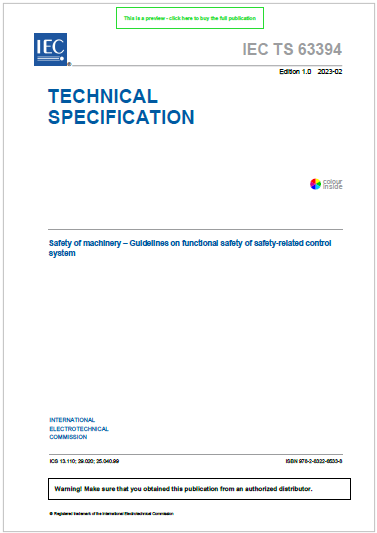
IEC TS 63394:2023 / Guidelines on functional safety of safety-related control system
IEC TS 63394:2023
Safety of machinery - Guidelines on functional safety of safety-related control system
Date: February 2023
In the context of the safety of machinery, the sector standard IEC 62061, along with ISO 13849 1, provides requirements to manufacturers of machines for the design, development and integration of safety-related control systems (SCS) or safety-related parts of control systems (SRP/CS), depending on technology used (mechanical, pneumatic, hydraulic or electrical technologies) to perform safety function(s). This document does not replace ISO 13849-1 and IEC 62061.
- Published: 29 April 2023
- Hits: 7305
Posted in News
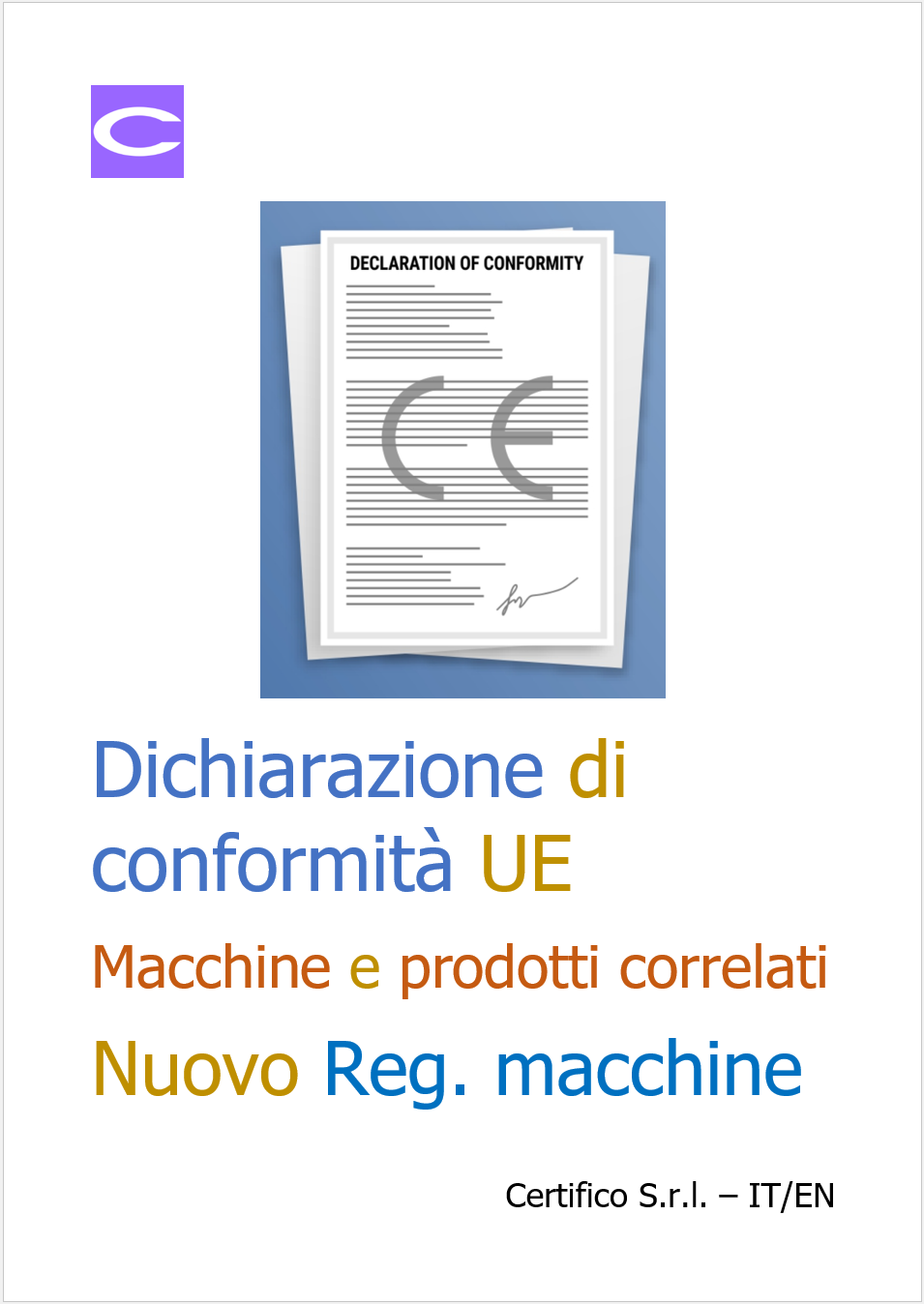
Dichiarazione di conformità UE di macchine e prodotti correlati / Nuovo Regolamento macchine 2023
Il presente documento illustra i novelli contenuti della dichiarazione di conformità UE relativa a macchine prodotti correlati così come normati dall’Accordo provvisorio risultante da negoziati interistituzionali per il nuovo regolamento macchine del 07.02.2023).
Inoltre, a titolo illustrativo, viene proposta una tavola raffronto inerente la dichiarazione di conformità UE, così strutturata:
- in colonna (1) contenuti dell’Allegato II Parte A della Direttiva 2006/42/CE (IT)
- in colonna (2) contenuti dell’Allegato V Parte A Bozza Regolamento macchine (EN)
- in colonna (3) Traduzione IT non ufficiale Bozza Regolamento macchine dei contenuti dell’Allegato V Parte A.
...
La dichiarazione di conformità UE attesta che la conformità ai requisiti essenziali di sicurezza e di tutela della salute applicabili di cui all'allegato III del Nuovo Regolamento Macchine è stata dimostrata.
La dichiarazione di conformità UE ha la struttura tipo di cui alla Parte A dell'allegato V, contiene gli elementi specificati nei moduli pertinenti di cui agli allegati VI, VIII, IX e IXa (nuovo modulo G - verifica delle unità) ed è continuamente aggiornata. È tradotta nella lingua o nelle lingue richieste dallo Stato membro sul cui mercato il prodotto macchina è immesso o messo a disposizione o messo in servizio.
Se alla macchina e i prodotti correlati si applicano più atti dell'Unione che prescrivono una dichiarazione di conformità UE, viene compilata un'unica dichiarazione di conformità UE in relazione a tali atti dell'Unione. Tale dichiarazione contiene gli estremi degli atti dell'Unione in questione, compresi i riferimenti della loro pubblicazione.
Con la dichiarazione di conformità UE, il fabbricante si assume la responsabilità della conformità della macchina o dei prodotti correlati ai requisiti stabiliti dal presente regolamento.
...
- Published: 16 April 2023
- Hits: 7870



































